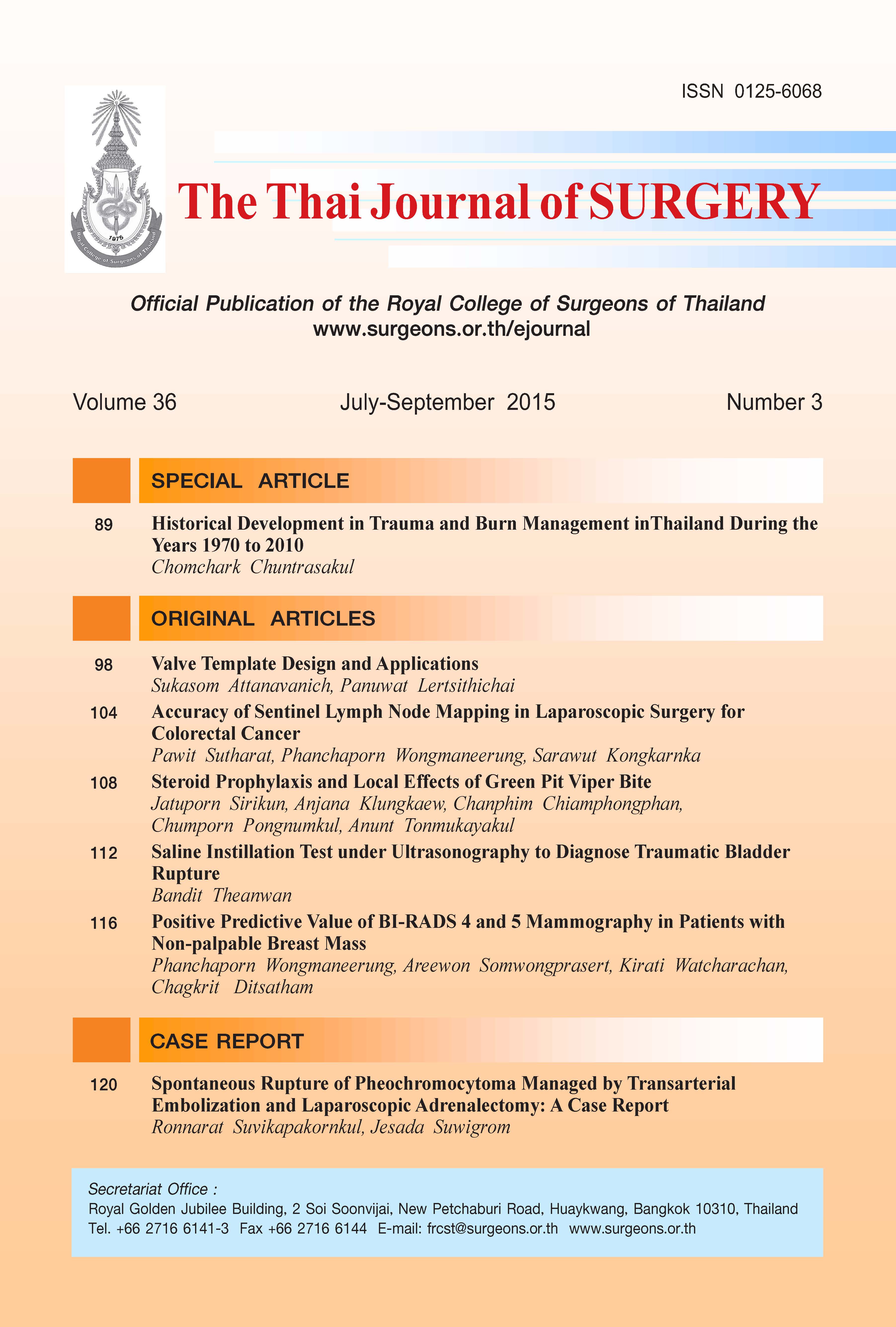Saline Instillation Test under Ultrasonography to Diagnose Traumatic Bladder Rupture
Keywords:
Bladder rupture injury, retrograde cystogram, saline instillation test, ultrasonographyAbstract
Background and Objective: Bladder rupture is still occasionally seen in trauma patients, especially in those withmultiple organ injuries. If suspected, a standard diagnostic method is to perform retrograde cystogram. However,
this requires that a radiologist be available, and is not applicable in patients with unstable vital signs. A diagnostic
procedure that is more readily available is the saline instillation test under ultrasonographic visualization. The aim
of the present study was to determine the accuracy of saline instillation test under ultrasonography in diagnosing
traumatic bladder rupture.
Methods: A diagnostic study of saline instillation test under ultrasonography was undertaken, using retrograde
cystogram, CT scan, and operative findings as standard comparators.
Results: During January 2012 and December 2014, 19 patients were recruited into the present study,
consisting of 13 patients with bladder ruptures, one patient without bladder rupture, and six patients with injuries
to kidney. We found the saline instillation test under ultrasonography to be accurate, with a sensitivity of 92.3%,
specificity of 100%, positive predictive value of 100%, and negative predictive value of 85.7%.
Conclusion: The saline instillation test under ultrasonography for the diagnosis of traumatic bladder rupture
has good sensitivity and specificity. It was easy to perform, convenient and fast, and can provide a timely diagnosis,
leading to prompt treatment and probably a reduction in complications.
References
evaluation of the trauma patient with suspected urologic
injury. Semin Urol 1995;13:9-24.
2. Carroll PR, McAninch JW. Major bladder trauma: Mechanism
of injury and a unified method of diagnosis and repair. J Urol
1984;132:254-7.
3. Corrine JN, Sandler CM. Mechanism of injury, patterns of
extravasation and management of extraperitoneal bladder
rupture due to blunt trauma. J Urol 1988;139:43-4.
4. Cass AS. The multiple injured patients with bladder trauma.
J Trauma 1984;24:731-4.
5. Flancbaum L, Morgen AS, Fleisher, et al. Blunt bladder
trauma: manifestations of severe injury. Urology 1988;31:220-
2.
6. Ziran BH, Chamberlin E, Shuler FD, Shah M. Delays and
difficulties in the diagnosis of lower urologic injuries in the
context of pelvic fractures. J Trauma 2005;58:533-7.
7. Rehm CG, Mure AJ, O’Malley KF, et al. Blunt traumatic
bladder rupture: the role of retrograde cystogram. Ann
Emerg Med 1991;20:845-7.
8. Baniel J, Schein M. The management of penetrating trauma
to the urinary tract. J Am Coll Surg 1994;178:417-25
9. Djakovic N, Plas E, et al. Guidelines on urological trauma. Eur
Assoc Urol 2012:34-43.
10. Hochberg E, Stone NN. Bladder rupture associated with
pelvic fracture due to blunt trauma. Urology 1993;41:531-3.
Downloads
Published
How to Cite
Issue
Section
License
Articles must be contributed solely to The Thai Journal of Surgery and when published become the property of the Royal College of Surgeons of Thailand. The Royal College of Surgeons of Thailand reserves copyright on all published materials and such materials may not be reproduced in any form without the written permission.



